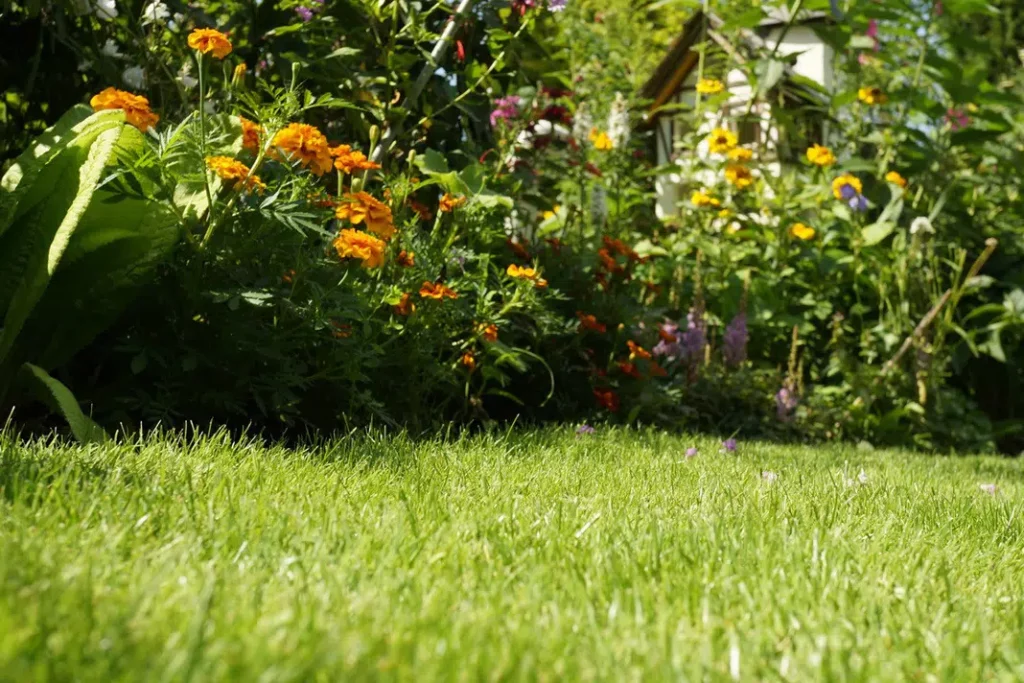A fresh, green lawn is the pride of every amateur gardener. In addition to water, light and nutrients, the pH value of the soil plays an elementary role in its growth. This is because only in the right pH range is the lawn at all able to absorb the nutrients provided and subsequently incorporate them into its metabolism. How to measure the soil pH correctly and how it can be improved towards the optimal pH range, we explain here.
Contents
The ideal pH value for lawns
Unfortunately, there is no such thing as the ideal pH value for lawns. This is because each nutrient can be optimally tapped by the plants in a slightly different pH range. Since it is not possible to simply adjust the value again and again for a single nutrient, it is therefore necessary to find an optimal average of the different requirements. If one believes the technical literature, the following values are on average best suited to allow the lawn the best possible growth:
- Light, sandy soils: 5.2 to 6.0
- Heavy, clayey soils: 6 to a maximum of 6.5
If the soil condition ranks somewhere between these extremes, the pH value in the lawn should also be adjusted to a medium value.
Measuring the pH value
For reliable statements on soil properties, it is important to have a reliable and at the same time simple measuring method. Only if the measurement results are reliably correct can conclusions be drawn about necessary measures to improve the soil. The following measuring methods are suitable for use by hobby gardeners and in connection with turf and its growth base:
- pH measuring strips
- Test sets with reagents
- Soil analysis
- Measuring instruments (so-called pH meters)
- Pointer plants
Measuring strips
pH measuring strips are pre-treated paper strips that indicate the pH value of an aqueous solution. To determine the soil value, a soil sample is mixed with distilled water and the strip is adjusted. Based on the discoloration of the strip, the exact pH value can be read in a comparison scale.
Test sets
Similar to the test strips, test sets work via reagents. According to instructions, a soil sample is prepared with pure water and then a test tablet is added. The developing color of the solution indicates the pH value of the soil.
Soil analysis
The most time-consuming, but also the most accurate, is the preparation of a soil analysis by a laboratory. For this purpose, a soil sample is taken and sent in for examination. In addition to the pH value, all other essential factors of a cultivated soil are determined, such as the nutrient content.
Measuring with electrical devices
So-called pH meters determine soil acidity via the electrical conductivity of an aqueous solution prepared from a soil sample. However, powerful measuring devices are very expensive and are mainly available in laboratory supplies. The simpler the pH meter is, the more inaccurate the results usually are.
Attention: Again and again one reads of very favorable multiple measuring instruments, which determine not only the soil acidity but also the light brightness, the temperature and the air humidity. We expressly warn against these devices. Usually it concerns thereby cheapest products from Far East, which determines none of the allegedly determinable values reliably and leads the hobby gardener with its concern for the lawn in the misleading, instead of supporting it.
Pointer plants
A natural alternative to the rough determination of soil acidity are so-called pointer plants. Depending on the pH, very specific plant species prefer to settle, indicating approximate acidity or alkalinity. Of course, they do not replace the effort of taking additional measurements for an exact determination. Well-known and easily recognizable indicator plants are:
For acid soils
- Sorrel
- Pansy
- Wood sorrel
- Horsetail
For alkaline soils
- Dandelion
- Field bindweed
- Cow parsnip
- Stinging nettle
- Corn poppy
- Coltsfoot

Improve pH
If you have come to the conclusion that the soil value is not in the optimal range for growing turf, there are two possibilities. If the value is too high, it is too alkaline. In this case, it should be lowered by adding acid. On the other hand, if the value is too low, it means the soil is too acidic. In this case, the value must be raised by adding alkaline substances. But how can the pH value be adjusted in practice and which substances are suitable for improving the soil?
Lowering the pH value
To lower a value that is too high, you ultimately have to add acid to the soil. The best way to do this is to incorporate soil-like substances with naturally high acidity into the soil:
- Peat
- Compost from oak run
- Needle soil (the soil from the immediate vicinity of coniferous trees)
- Ferrous sulfate (salt of sulfuric acid)
- Grape marc (solid residue from pressing grapes during juice or wine production)
- Mulch layer of coniferous wood and oak leaves
- Sulfur (especially in heavily compacted soils)
- Rainwater (for irrigation instead of tap water)
Raising the pH value
On the other hand, if the lawn is too acidic, it is necessary to raise the pH. Contrary to the rather extensive list of common additions for lowering the value, only very few substances are used for raising the value:
- Potassium hydroxide (caustic potash)
- Potassium carbonate
- Soda
- Ground lime
No matter what substance you choose to improve the soil, the optimal would be to incorporate it before seeding the lawn. Then the additives can be spread over the soil and easily worked into the top layer of soil with a hoe, digging fork or even power hoe. However, it will often be the case that already after sowing you will notice that the plantlets do not develop properly or an existing lawn becomes unsightly and no longer thrives. In these cases, the aggregates should be evenly distributed over the lawn and only moderately incorporated. A good option is to combine this with early season mulching and use the loosening of the root system at the same time to incorporate compost, sulfur, lime, etc. However, too intensive incorporation should be avoided, otherwise damage to the plants may occur, which can also adversely affect the soil balance.
Tip: If the lawn is already present, it may be useful to resort to the “chemical” variants of soil improvement, that is, sulfur, iron sulfate, etc.. These substances are in powder form and can thus be easily sprinkled on the lawn. Just by watering or rain they are well washed into the soil and can act there without additional effort.


